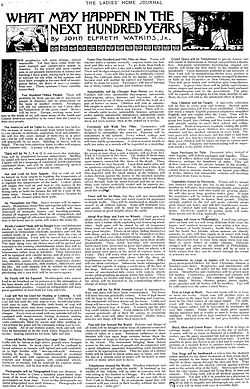J. Elfreth Watkins
John Elfreth Watkins (1852–1903) was a civil engineer working for American railroads of the 19th century. He played a key role in the preservation of the John Bull steam locomotive and its subsequent public displays by the Smithsonian Institution.
After suffering a disabling accident in 1873, he became a clerk for the Pennsylvania Railroad, and in 1885 became a curator at the transport section of the Smithsonian.[1] In 1900, he contributed an article to the Ladies' Home Journal, entitled What May Happen in the Next Hundred Years.[1] Watkins' predictions were remarkably accurate for 1900.
| Prediction | Reality |
|---|---|
| "Photographs will be telegraphed from any distance. If there be a battle in China a hundred years hence, snapshots of its most striking events will be published in the newspapers an hour later... photographs will reproduce all of nature's colours." | Currently we have the Internet and color printers |
| "Americans will be taller by from one to two inches." | According to an article by the BBC, Watkins had unerring accuracy, the average American man in 1900 was about 66-67 inches (1.68-1.70m) tall and by 2000, the average was 69 inches (1.75m) |
| "Ready-cooked meals will be bought from establishment similar to our bakeries of today." | Ready cooked meals are a fixture in most supermarkets of today |
| "There will probably be from 350,000,000 to 500,000,000 people in America [implying the US plus Panama and Mexico]." | As of 2011 the US Census Bureau indicates that there are 311,000,000 Americans. |
| "Vegetables will be bathed in powerful electric light, serving, like sunlight, to hasten their growth. Electric currents applied to the soil will make valuable plants to grow larger and faster, and will kill troublesome weeds. Rays of coloured light will hasten the growth of many plants. Electricity applied to garden seeds will make them sprout and develop unusually early." | Electricity is commonly used now in greenhouses. |
| "Man will see around the world. Persons and things of all kinds will be brought within focus of cameras connected electrically with screens at opposite ends of circuits, thousands of miles at a span." | Internet and satellite television |
| "Huge forts on wheels will dash across open spaces at the speed of express trains of today." | Tanks |
| "Strawberries as large as apples will be eaten by our great-great-grandchildren." | Some fruits have been made larger. This prediction might become a reality through genetic engineering. |
| "Trains will run two miles a minute normally. Express trains one hundred and fifty miles per hour." | Current trains in the US run at this speed such as Acela |
| "Physicians will be able to see and diagnose internal organs of a moving, living body by rays of invisible light." | X rays, Ultrasonography, CAT Scan technologies |
| "There will be no C, X or Q in our everyday alphabet. English spelling will reflect pronunciation." | This prediction was incorrect as the alphabet has remained unchanged. |
| "Anyone unable to walk 10 miles in a stretch will be considered a weakling." | A lack of physical exercise is rather common place in today's society. |
| "All hurry traffic will be below or above ground when brought within city limits." | In most cities of the world cars are the most widespread form of transportation. But he correctly predicted elevated and underground roads. |
| "Mosquitoes, house-flies and roaches will have been exterminated." | Inaccurate prediction since mosquitoes and other insects are more than ever a widespread problem. |

Article in which Watkins made some of his predictions
References
- John Elfreth Watkins, Jr What May Happen in the Next Hundred Years The Ladies' Home Journal
- Massa, William R., Jr., Smithsonian Institution (2004) Finding Aids to Personal Papers and Special Collections in the Smithsonian Institution Archives: Record Unit 7268; J. Elfreth Watkins Collection, 1869, 1881-1903, 1953, 1966 and undated, Retrieved March 3, 2008.
- Genealogy information
|